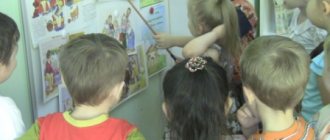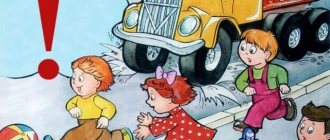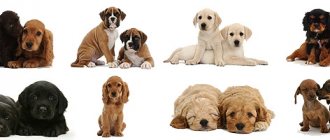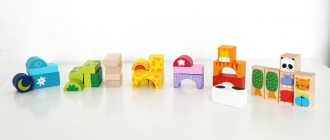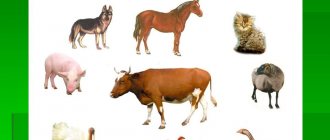Summary of educational activities in the early age group on cognitive development. Cat and kitten
Summary of GCD classes for young children in the educational field of knowledge on the topic “My furry friends
Topic: Cat with kittens. Game "Feed the cat and kitten." Goal: introduce children to domestic animals: cats and kittens, teach them to name parts of a toy, learn to answer questions, pronounce onomatopoeia, compare objects according to several characteristics (size, color, develop attention, memory, speech, general motor skills, tactile sensations. Objectives: teach to look at the plot picture “Cat with kittens” with interest; at the request of the teacher, talk about what is shown in the picture, about the toys “Cat” and “Kitten”; take part in the game “Find bowls for a cat and kitten”, show the basic movements made by kittens . Materials and equipment: plot picture “Cat with kittens”, three pictures of kittens - gray, white, black, toy cat and kitten, toy bowls of different sizes.
Course of the lesson
1. Organizational moment. Educator: Children, guess who it is? Milk drinks, sings songs, washes himself clean, but doesn’t know about water. (cat) 2. Main part: Story based on a plot picture. The teacher shows pictures depicting three kittens and tells
the fairy tale “Three Kittens.” Three kittens - black, gray and white - They saw a mouse and rushed after it!
The mouse jumped into a jar of flour. The kittens are after her! The mouse ran away. And three white kittens crawled out of the jar. Three white kittens saw a frog in the yard and rushed after it! The frog jumped into the old samovar pipe. The kittens are after her! The frog galloped away, and three black kittens crawled out of the chimney. Three black kittens saw a fish in the pond and rushed after it! The fish swam away, and three wet kittens emerged from the water. Three wet kittens went home. On the way, they dried out and became as they were: black, gray and white. The teacher shows a picture with a cat and kittens.
The cat is big and the kittens are small.
What cat? (big.) What kind of kittens are they? (small.) Kittens love to play: roll balls and balls on the floor, run after each other and meow: “Meow, meow,” and the cat washes itself with its paw and purrs: “Purr-purr.” How do kittens meow? How does a cat purr? (children repeat the onomatopoeia that the teacher said.) Show the kittens in the picture. (Children show.) What are they doing? (They play and meow.) Show the cat in the picture. (Children show.) What are they doing? (washes itself, purrs.) Physical education lesson The kitten is fiddling with a ball: Movement “the kitten is scratching” It will crawl up to it secretly, Then it will start throwing itself at the ball, (jump in place, then squat down)
It will push it, it will jump to the side.
(jump on the spot)
He can’t guess.
(spread your arms to the sides)
That there is not a mouse here, but a ball.
3. Looking at toys. Educator: Look, the kitten came running to watch you play (unnoticeably takes out the kitten’s toy, then the cat, and here is her mother cat. The kitten and the cat love to be stroked. (stroke the toys, the children repeat the actions.) Tell me which kitten ? (small, fluffy, soft.) What kind of cat is it? (big, fluffy.) How do they meow, purr? (children pronounce onomatopoeia.) 4. Game “Let's feed the cat and kitten.” Educator: Do you want to feed the cat and kitten with milk? (children answer.) Look, what kind of bowl is for a kitten and a cat? Let's look at the kitten. What kind of kitten (small) The kitten will drink milk from a small bowl. Where is such a bowl? (children find a small one among the bowls, pour milk from a plastic bottle. ) And which cat is big or small? (big.) The cat says that its big bowl. Where is that bowl? (children find a big bowl and pour milk from a bottle into it.) Educator: Well done guys! Now you know what kind of kittens there are , soft, fluffy, affectionate, the way they meow and lap up milk. You have learned to pet them and feed them from a bowl. And now our cat and kitten have gone to bed.
We recommend watching:
Notes on joint play activities in an early age group (2-3 years old) Notes on cognitive development in the first junior group on the topic: Pets Notes on speech development in the second junior group. Pets Lesson notes for the younger group. Pets
Similar articles:
Summary of a lesson on the topic “Fruits” for children 2-3 years old
Lesson summary for an early age group. Cockerel
Lesson summary for an early age group. Dandelion
Summary of a game developmental lesson in an early age group on the topic: Rays of the sun
Game development activity in kindergarten for children of the third year of life
Progress of the lesson
Walsh. : Guess my riddle “Mug with a mustache
But I don’t know about water.” Who is this?
Children: Cat .
Walsh. : Where does the cat ?
Walsh. : And what kind of animal is a cat
Children: A cat is a pet .
Walsh. : Well done. You probably noticed the picture that I prepared for you?
Educate : You looked at the picture and must have already decided what it should be called. The title should not be very long, but it should be clear what you are talking about. (children's answers)
.
What do you see in this picture ?
The teacher asks questions for clarification: What is the cat like (big, fluffy, beautiful, What does the cat ? What name can you give the cat ? (Murka, Vasilisa...)
Who else is depicted
(
kittens ) How do
kittens differ from each other (they differ in color)
How else do they differ?
Look what each kitten is doing (one is playing with a ball, the second is sleeping, the third is lapping up milk)
. : Guys, let’s enter the picture and imagine that we are nearby... What do you hear (Phonogram of the sound of little kittens )
Children: They sniffle, snort, meow... -When kittens sniffle (when they want to eat, and purr (satisfied, full)
.
Educate : Imagine that you are holding a kitten in your arms, stroke it, how do you feel?
Walsh. : Wow, I want to exercise something, I suggest you play:
You know me closely, I am a friendly pussy. Tassels on the ears at the top. The claws are hidden in the pillows. In the dark I see vigilantly, I won’t offend you in vain. But teasing me is dangerous, I scratch terribly.
Children go to their chairs and the phonogram of the mother cat .
-The guys whose voice we hear ( cats )
-Do you know what she asks you for? Mother cat wants you to write a story about her and her kittens . She will be very interested. I will help you.
-What words can you use to start a story (The picture shows , Once upon a time....)
-How can you finish the story ? (I liked the cat family . I liked the picture because )
-So, I’m starting, and you help me.
The picture shows ... Cat . The cat is very ... (beautiful, kind...)
.
The cat has kind and intelligent eyes, a thick, beautiful fur coat. Next to her…. kittens . What kind of kittens ? Kitty... The toy is very playful and loves to play with the ball. Fluffy has sweet dreams. Murzik the cat laps up warm milk and purrs sweetly. They get along very well with their mother cat .
Whole family to gather! - Guys, who wants to tell their story based on the picture ?
( Children's stories , optional)
of a mother cat sounds .
The teacher shows the cat and immediately invites everyone to the carpet.
-Guys, look who came to us! Yes, it’s our cat from the picture who came to thank you for your stories .
-And she came not empty-handed, but with magic balls that will turn you into kittens .
Children lie on the rug, play with balls, with a cat .
Didactic game “Oh, those birds!” Oh, wow, these birds! A teaching aid for children 4–6 years old. Objectives: to consolidate children's knowledge about birds; introduce the classification of birds (wintering.
Game lesson to familiarize yourself with the environment “Spring” Spring Goals: formation of competent speech, expansion of vocabulary on the topic “Spring”, development of the ability to select actions and signs.
Source
Summary of the lesson “Cats with kittens” in the middle group
The activity is a game for children 3-5 years old.
Theme “Mother cat and kittens” Program content : to promote the emotional experience of cognitive information through play improvisations and the establishment by children of certain analogies between the behavior of parent animals and their cubs and human behavior; to instill in children a feeling of love and gratitude for their mother and to show a kind attitude towards representatives of the animal world; pay special attention to the mother cat’s treatment of her offspring (feeding, washing, playing, training, protection); practice comparing the appearance and habits of an adult animal and its cub; in creative activities, encourage children to create various images of baby kittens using pieces of fabric, fur, and natural materials; activate children’s spontaneous verbal communication with each other and with adults. Activation of the dictionary: names of cat body parts, habits. Material: photographs or illustrations of cats and kittens (separately); toys: cube, pyramid, rattle; two large silhouettes of cats, cut out of soft fluffy fabric and pasted onto sheets of whatman paper or cardboard, paper silhouettes of small kittens; pieces of fabric, fur for decorating the ears, paws and tails of small kittens, brushes, paste, napkins.
Preliminary work: observing the behavior of cats and kittens at home, looking at photographs or illustrations of these animals, collecting photographs and postcards with pictures of cats and kittens by children and parents.
Progress of the game
The teacher calls the children for a dialogue using a poem by Natalia Bromley:
What is the very first word?
What's the most important word? What is the brightest word? Mother! Pronounces in syllables. And I want again, And I want again To say it quietly. Children say the word “mother” in a quiet voice.
Say it loud.
They say the word “mother” loudly. The most important word of a child: Ma-ma! Choral pronunciation of the word. Educator . I know that you love your mothers very much, and they love you too. And now I will show you photographs of other mothers who also love their children very, very much. Leads the children to two photo newspapers
: “Cat Moms” and “Our Kittens.”
The teacher gives the children time to express their delight at the cat families. - What is the name of this mother, who also loves her children very much? (Makes a hand gesture towards illustrations of cats.) What are the names of her cubs? Tell me, children, do you look like your mother? How? How are kittens similar to their mother cat? (Fur color, body parts.) Now let's help every baby kitten find his mother cat. The teacher takes out photographs or postcards of kittens from the slots of the newspaper and distributes them to the children. Every child looks for a mother for his kitten based on external resemblance. The wall newspaper “Cat Mom” should be designed in the form of a narrow long rectangle and located at the children’s eye level. Under the illustration-photo of each cat, cuts should be made, with the help of which the child and the teacher could insert an image of a baby kitten. Having rejoiced with the children over the found “mother” cats, the teacher finds out the signs of similarities and differences between the kittens and their “mothers”. Educator. Do you children want this kitten to come to life? Then let's all cover this photo of the kitten with our palm and think something good and affectionate about it. If you have the opportunity to bring a real kitten, you should do it! If this possibility is not available, then the kitten can be represented by a small fluffy toy, which the children pass to each other, standing in a circle, while simultaneously calling out pleasant descriptive words for their little friend. For example: “You are so small! How fluffy you are! You have beautiful green eyes! I really like you!". The teacher helps in choosing kind words for the kitten. Then he returns the kitten to the “mother” cat. Educator. Which one of you has a cat, cat or kitten at home? Maybe some of you currently have a mother cat with kittens living at home? Tell us how a cat cares for its cubs. The teacher summarizes the children’s statements:
“Cat mother is very gentle and caring.
She feeds the kittens, washes them, plays with them, protects them from danger.” The teacher offers the children a game exercise “Cat mothers protect their kittens.” One subgroup of children plays the role of mother cats, the other - their cubs. Two children play the role of a bird of prey. “Birds” approach the “kittens”, “mother cats” depict hissing, scratching, biting. The teacher finds out from the children which of them at home mom, dad or relatives also call a kitten and why. Educator . So you children are like kittens? With what? (Behavior.) Do you like to play pranks? And kittens too. (Children pronounce this phrase in chorus.) Do you like to jump? And kittens too. Do you like to play with toys? And kittens too. Do you have a favorite toy? What is it called? The teacher invites the children to look at a photograph of a small child (baby) and find his favorite toy. On a separate table there are a variety of toys, among which there must be a bright rattle. — What do you think, children, do kittens have a favorite toy and what is it called? If the kids find it difficult to answer this question, then the teacher takes them to photographic portraits of cats and says that the kittens’ favorite toy is depicted in each illustration. Encourages children to make any suggestions. Educator. For little kittens, the very first and favorite toy is their mother’s cat’s tail. How many of you have seen how kittens play with the tail of their mother cat? Want to see this? Then I will now turn into... who? That's right, like a mother cat. Who will you all be? Kittens. The game is called “Catch Mommy’s Tail!” A thick rope with a fluffy tip is tied to the teacher's belt. By moving the “tail” rope with her hand, the “mother cat” teaches the “kittens” to catch it. Then the teacher offers the children a game that real cats play with their cubs. The game is called "Cat and Mouse". Under the teacher’s comments, the children perform the named play actions: “The mother cat is sitting on the grass, her tail fluffed, and the kittens are sitting next to her. Suddenly my mother's tail begins to twitch. Like this. (Show.) What do kittens do? They became quiet and looked attentively at the mouse-tail. The “tail mouse” crawls slowly, and the kittens also crawl behind it slowly. The kittens stopped, huddled into a ball and jumped on the “mouse”. Gotcha! When conducting game exercises, you can use musical accompaniment. The game-activity ends with the children’s joint creative activity on the topic “Our cat gave birth to kittens yesterday.” The teacher gives two subgroups of children each one large silhouette of an adult cat, made of fluffy colored fabric or fur and pasted on whatman paper or cardboard. Each child receives a monochromatic outline of a small kitten and draws its nose, mouth, eyes and whiskers. Pieces of fluffy fabric or fur are glued to the kitten's ears, paws, and tail. And then, having come up with a name for their kitten, each child places it in any position near the “mother cat”. The examination of two “large” cat families ends with the performance of songs about cats. Homework for parents: together with the child, create either a “photo film”, or a video film, or a homemade book on the topic “One day in the life of an animal.” Author's photographs, videos, books are always discussed in the family and children's group.
We recommend watching:
Cognition lesson in the second junior group of a preschool educational institution. Pets Summary of a lesson on cognitive development in the middle group on the topic “My Family” Entertainment “Titmouse Day” in kindergarten in the middle group Subject-based physical education lesson in the middle group of the kindergarten
Similar articles:
Summary of a lesson on emotional development in the middle group of kindergarten
Lesson summary for the middle group “Our Kindergarten”
Lesson notes for the middle group “Bus Driver”
